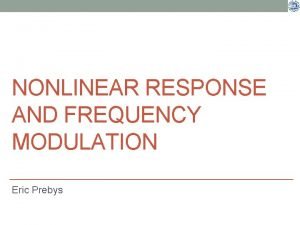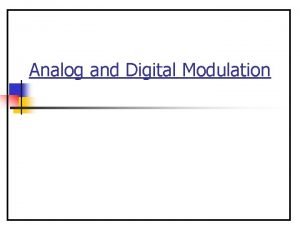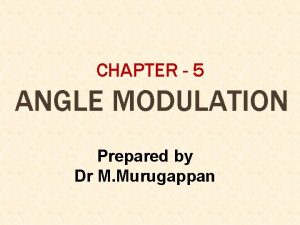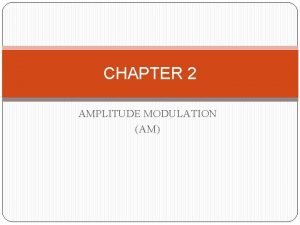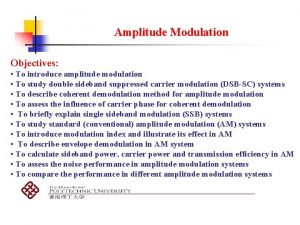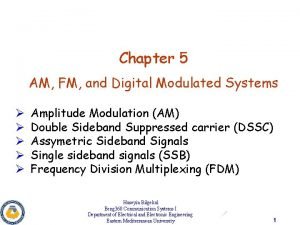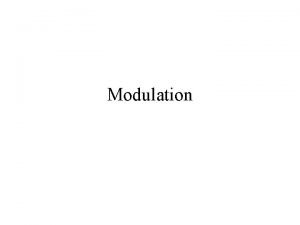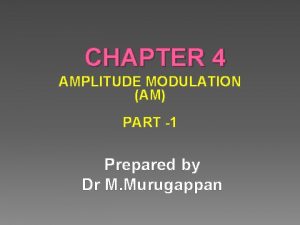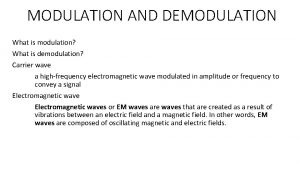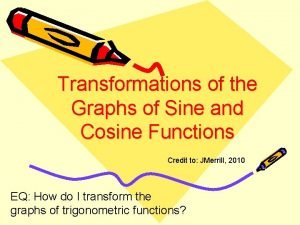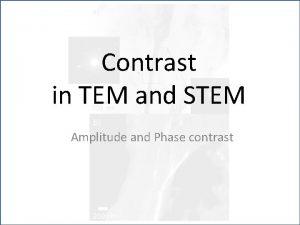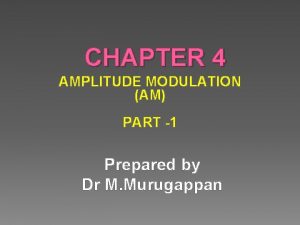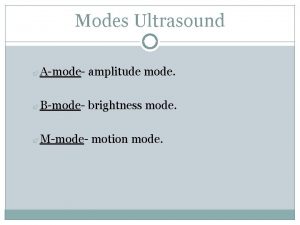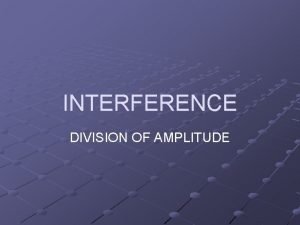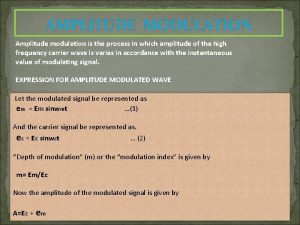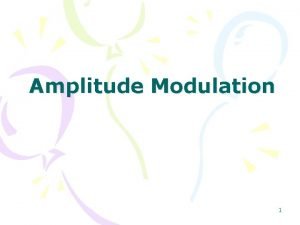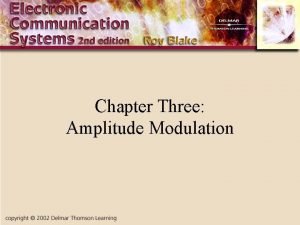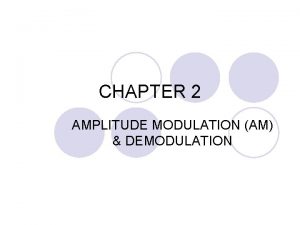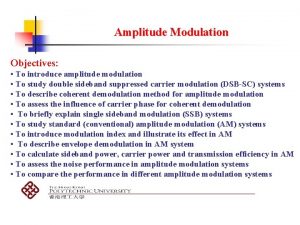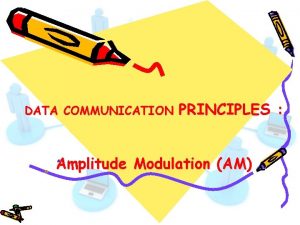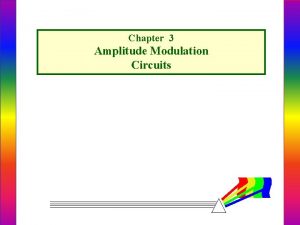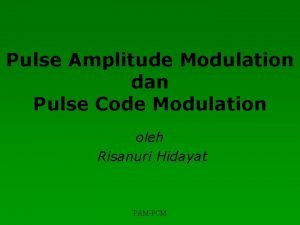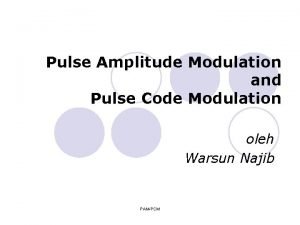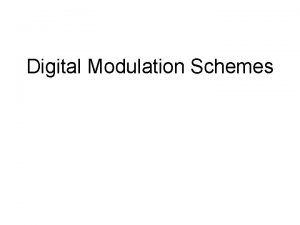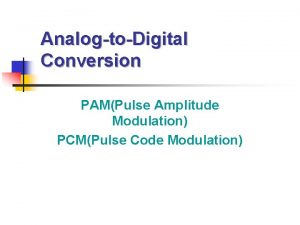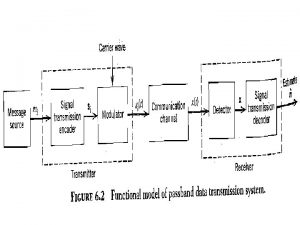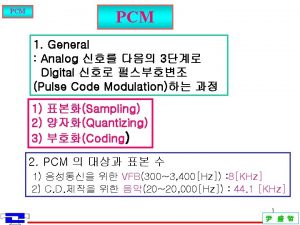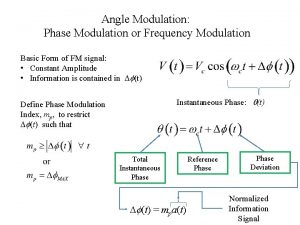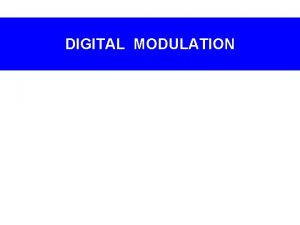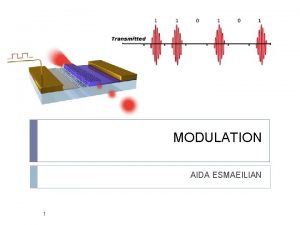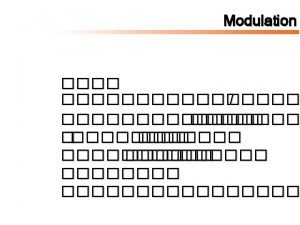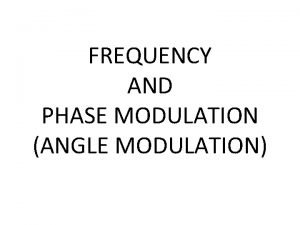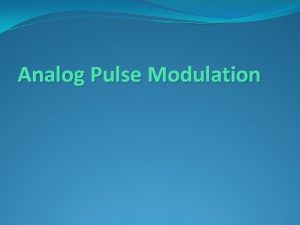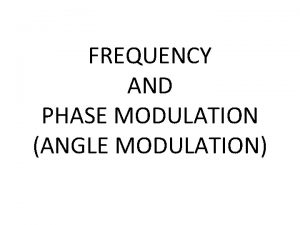Standard Amplitude Modulation AM 1 Standard Amplitude Modulation


























- Slides: 26

Standard Amplitude Modulation (AM) 1

Standard Amplitude Modulation (AM) � In the DSP-SC demodulation, a receiver must generate a local carrier in frequency and phase synchronism with the carrier used for modulation. � This call for a sophisticated receiver and could be quit costly. � The other alternative is for the transmitter to transmit a carrier Ac cos (ωct) along with the modulated signal m(t) cos (ωct). so there is no need to generate a carrier at the receiver and this is the idea of the standard AM. 2

Modulation �The modulating signal (information or baseband signal) �The carrier signal is �The modulated signal 3

Modulation 4

Modulation – case 1 When ( is nonnegative) for all value of t. � The envelop has the same 5 shape as m(t). � Hence, we can recover m(t) from this envelop. � At the receiver, the detection is extremely simple and inexpensive operation, which doesn’t require generation of a local carrier for demodulation.

Modulation – case 2 The condition is not satisfied. �The envelop shape is not as m(t). �So, we can’t recover m(t) from this envelop. �We can’t build a simple receiver. 6

Modulation Index � Let Am the peak amplitude of m(t) and Ac is the carrier amplitude. � We define modulation index as: � When : this mean that for all t and the SAM(t) (modulated signal) can be demodulated by the envelop detector. � When (overmodulation): this mean that A + m(t) is not ≥ 0 for all t and the option of envelop detection is no longer viable. 7

Spectrum �The spectrum of the modulated signal SAM(t) is the same as that of m(t) cos (ωct) plus tow additional impulses at + ωc and - ωc. �If then 8

Spectrum LSB 9 USB

Spectrum �The modulated signal spectrum centered at ωc is composed of three parts: �An impulse at the carrier frequency ωc �The upper sideband (USB), a portion that lies above ωc whose highest frequency component is at ωc + ωM � The lower sideband (LSB), a portion that lies below ωc whose lowest frequency component is at ωc - ωM � The bandwidth of the modulated waveform is twice the information signal bandwidth. 10

Transmission Power �The advantage of envelop detection in the standard AM has its price. �Recall, the transmission power and the channel bandwidth are the two primary communication resources and should be used efficiently. �The transmission of the carrier wave represent a waste of power. �In the standard AM, only a fraction of the total transmitted power is actually for m(t). 11

Demodulation �In the standard AM modulation, the modulation index should be in order to demodulate the received modulated signal by using an envelop detector. 12

Single-Sideband (SSB) Modulation 13

Introduction �Standard AM and DSB-SC modulations has two sidebands: LSB and USB. �These two methods waste the channel bandwidth because they both require a transmission bandwidth equal to twice the message bandwidth. 14

Introduction �Note that the USB and the LSB are symmetric about the carrier frequency. �Hence, given the spectra of either sideband, we can determine the other. �So, the transmission of either sideband is sufficient to reconstruct the message signal m(t) at the receiver. �Thus, the bandwidth of the transmitted signal ( modulated signal) will be the bandwidth of the modulating signal ( baseband signal) 15

Single-Sideband (SSB) Modulation �In single-sideband (SSB) modulation just only one sideband is transmitted. 16

Generation of SSB Signals �One way to generate an SSB signal is to: �generate a DSB signal first, � and then suppress one of its sidebands by filtering ( band-pass filter designed to pass one of the sidebands of the modulated signal) 17

Spectrum of SSB Signals e filter must have sharp cutoff characteristics to eliminate the undesired sideband 18

Demodulation �Demodulation of SSB signals can be achieved easily by using the coherent detector as used in the DSB demodulation, that is, by multiplying by a local carrier and passing the resulting signal through a low-pass filter. 19

Demodulation 20

Vestigial-Sideband (VSB) modulation 21

Vestigial-Sideband (VSB) modulation �Vestigial-Sideband (VSB) modulation is a compromise between SSB and DSB modulations. �In this modulation scheme, one sideband is passed almost completely, whereas just a trace, or vestige, of the other sideband is retained. �The typical bandwidth required to transmit a VSB signal is about 1. 25 that of SSB. �VSB is used for transmission of the video signal in commercial television broadcasting. 22

Generation of VSB Signals �A VSB signal can be generated by passing a DSB signal through a sideband-shaping filter [VSB filter]. 23

24

Demodulation of VSB �The m(t) can be recovered by synchronous or coherent demodulation , that is, by multiplying by a local carrier and passing the resulting signal through a low-pass filter. 25

26
 Amplitude modulation vs frequency modulation
Amplitude modulation vs frequency modulation Wave modulation
Wave modulation Advantages of angle modulation over amplitude modulation
Advantages of angle modulation over amplitude modulation Principle of am
Principle of am Dpcm advantages and disadvantages
Dpcm advantages and disadvantages Envelop
Envelop Ussb signal
Ussb signal Frequency modulation
Frequency modulation Dscfc
Dscfc What is demodulation? *
What is demodulation? * Laisvieji svyravimai
Laisvieji svyravimai Gmr head amplitude
Gmr head amplitude Teramond
Teramond Amplitude definition
Amplitude definition How to find period on sine graph
How to find period on sine graph Amplitude wavelength and frequency
Amplitude wavelength and frequency Amplitude is measured as the height of deflection ____.
Amplitude is measured as the height of deflection ____. Amplitude contrast
Amplitude contrast Unmodulated carrier amplitude formula
Unmodulated carrier amplitude formula Ultrasound display modes
Ultrasound display modes Amolitude
Amolitude Svyravimo amplitude
Svyravimo amplitude Solid liquid gas
Solid liquid gas Interference by division of amplitude
Interference by division of amplitude Amplitude courant alternatif
Amplitude courant alternatif Ecological amplitude definition
Ecological amplitude definition Region growing segmentation
Region growing segmentation
